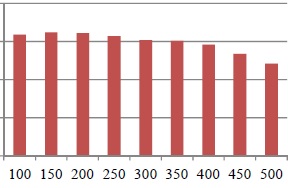Clustering Data Remunerasi PNS Menggunakan Metode K-Means Clustering Dan Local Outlier Factor
Abstract
Remuneration is a work benefit in the form of salary, honorarium, fixed allowances, incentives, bonuses for achievement, severance pay, and / pension funds. Remuneration will eliminate the assumption that there is no positive correlation between performance and income. This means that employees / employees who are performing well will have unequal income. The government has tried to change the payroll system to be better through the remuneration system. Remuneration consists of basic salary plus benefits derived from pure rupiah and other benefits originating from Non-Tax State Revenues. Problem with remuneration is that the validation carried out by the direct supervisor of the employee concerned is still doubtful. Based on this, we need a system that can detect outlier data from civil servant remuneration data and classify the data using data mining techniques. This research aims to classify data on civil servant remuneration using the k-means clustering method with improvisation at the pre-processing stage and determining the optimum number of clusters. Local Outlier Factor method with a MinPts value of 150 can detect the most outlier data with 162 data outliers detected or 22,98%. Number of optimum clusters by the elbow method is 4 clusters with a Silhoutte value of 0,542 and Dunn of 0,040.
Keywords — Clustering, K-Means, LOF, Outlier
Downloads
References
[2] N. G. Yudiarta, M. Sudarma, dan W. G. Ariastina, “Pengelompokan Berita Pada Unstructured Textual Data,” Maj. Ilm. Teknol. Elektro, vol. 17, no. 3, hal. 339–344, 2018.
[3] M. R. Ridlo, S. Defiyanti, dan A. Primajaya, “Implementasi Algoritme K-Means Untuk Pemetaan Produktivitas Panen Padi Di Kabupaten Karawang,” in CITEE 2017, 2017, hal. 426–433.
[4] Widiarina, “Algoritma Cluster Dinamik Untuk Optimasi Cluster Pada Algoritma K-Means Dalam Pemetaan Nasabah Potensial Algoritma Cluster Dinamik Untuk Optimasi Cluster Pada Algoritma K-Means Dalam,” Tesis Magister Ilmu Komputer, Nusa Mandiri, vol. 1, no. 1, hal. 33–36, 2013.
[5] M. Nishom dan M. Y. Fathoni, “Implementasi Pendekatan Rule-Of-Thumb untuk Optimasi Algoritma K-Means Clustering,” J. Inform. J. Pengemb. IT, vol. 3, no. 2, hal. 237–241, 2018.
[6] K. G. Sharma, Y. Singh, dan A. K. Srivastava, “Variance on Factor,” in IMPACT, 2017, hal. 101–103.
[7] N. P. E. Merliana, E. Ernawati, dan A. J. Santoso, “ANALISA Penentuan Jumlah Cluster Terbaik Pada Metode K-Means Clustering,” in Prosiding seminar nasional multi disiplin ilmu, 2015, hal. 978–979.
[8] V. Bhatt, M. Dhakar, dan B. K. Chaurasia, “Filtered Clustering Based on Local Outlier Factor in Data Mining,” vol. 9, no. 5, hal. 275–282, 2016.
[9] N. Idham, “Penerapan Outlier Analysis Sebagai Salah Satu Rekomendasi Kelompok Belajar Terhadap Siswa Kelas 6 Di Sdn Pagelaran II Program Studi Teknik Informatika,” Universitas Komputer Indonesia, 2017.
[10] Z. Li et al., “File yang so pernah download,” Jutei, vol. 2, no. 2, hal. 23–32, 2018.
[11] N. B. Hartono, “Analisis Outlier Dan Heteroskedastisitas Dengan Menggunakan Regresi Robust Weight Least Square,” Universitas Negeri Semarang, 2016.
[12] B. Santoso, I. Cholissodin, dan B. D. Setiawan, “Optimasi K-Means untuk Clustering Kinerja Akademik Dosen Menggunakan Algoritme Genetika,” J. Pengemb. Teknol. Inf. dan Ilmu Komput., vol. 1, no. 12, hal. 1652–1659, 2017.
[13] G. Ngurah, W. Paramartha, D. E. Ratnawati, dan A. W. Widodo, “Analisis Perbandingan Metode K-Means Dengan Improved Semi- Supervised K-Means Pada Data Indeks Pembangunan Manusia ( IPM ),” vol. 1, no. 9, hal. 813–824, 2017.
[14] A. R. Mamat, F. S. Mohamed, dan M. A. Mohamed, “Silhouette index for determining optimal k-means clustering on images in different color models,” 106 Int. J. Eng. Technol., vol. 7, no. 2, hal. 105–109, 2018.
[15] A. D. Savitri, F. A. Bachtiar, dan N. Y. Setiawan, “Segmentasi Pelanggan Menggunakan Metode K-Means Clustering Berdasarkan Model RFM Pada Klinik Kecantikan ( Studi Kasus : Belle Crown Malang ),” J. Pengemb. Teknol. Inf. dan Ilmu Komput., vol. 2, no. 9, hal. 2957–2966, 2018.
[16] Z. Arifin, S. Santosa, dan M. A. Soeleman, “Klasterisasi Genre Cerpen Kompas Menggunakan Agglomerative Hierarchical Clustering- Single Linkage,” J. Teknol. Inf., vol. 13, no. 2, hal. 92–100, 2017.


This work is licensed under a Creative Commons Attribution-NonCommercial-NoDerivatives 4.0 International License.

This work is licensed under a Creative Commons Attribution 4.0 International License




